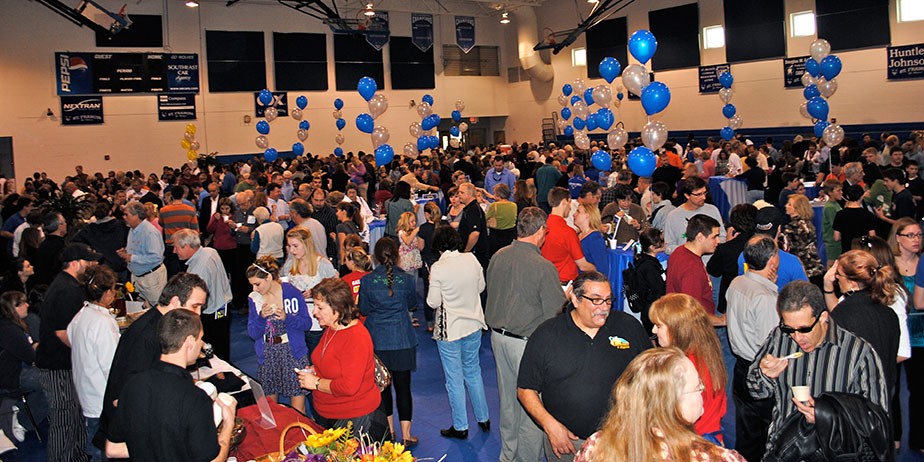The contemporary art porcelains resting on the shelves of John Tilton’s studio unmask their brilliant, diligent maker. Balanced to precision and carefully crafted with attention to even the minutest of details—these pieces epitomize the man behind the potter’s wheel. However, this modest, yet enthusiastic artist wasn’t always unearthing his passions in a studio filled with clay. He actually grew up with an attraction to left-brain interests, like analytics, logistics—and especially numbers.
It was his love for numbers that led him to pursue a Ph.D. in mathematics at the University of Florida, which was, coincidentally, the place where his love for pottery began. After one course at the Reitz Union, he was intrigued. And after an elective class in ceramics, he was hooked.
“I was about to get my master’s when I thought, ‘I’m really not that crazy about living my life as a mathematician,’” he recalled. “There were all these neat people in pottery.”
Fitting in with the eclectic artists in the pottery community led to his artistic unearthing taking off. “It sort of flowed from one into the other,” Tilton said.
He moved out to California in 1969, where he worked with PeterashVoulkos, arguably the most influential ceramist of the 20th century, at University of California, Berkeley.
“I was a guy who made clay in exchange for a little studio space at the school,” he said. “I had initially been inspired by Chuck Hindes, my teacher at UF, and being in California solidified, without a doubt, that I would make my life in pottery. I was able to be in the energy of several great ceramists, and that was the catalyst for the passion I still have today. But I had only been making pots for a year, and much of it was over my head.”
A few months later, he returned to Gainesville, and was accepted into the ceramics graduate program at the University of South Florida in Tampa. After earning his Master of Fine Arts in 1972, he moved to a quaint town in western New York called Alfred, which is home to the New York State College of Ceramics. There, he rented a small studio just miles from the college, which he described as one of the best places to study ceramics in the world. By the end of that winter, he returned to Gainesville.
“There was just something about Gainesville that I loved,” Tilton said. “For one thing it was the music. I played a lot of music (guitar) with a lot of wonderful musicians and there was music every night. I had a lot of friends here; it just felt like home when I moved back.”
In 1978 he moved to The Temple of the Universe, a spiritual community north of Gainesville, and began to make pots in the corner of a room that is now his large, spacious studio.
“I have always wanted to be happy above all else, and I found a special energy here. I wanted to live in this sanctuary and meditate and sing, and devote my life to growing spiritually,” he said. “It was a great decision.”
The Temple, which is where he has lived and worked for the last 35 years, has also helped Tilton evolve his meditation, which directly reflects the quiet, stillness of his pieces. He aims to always work under the Buddhist mentality of “no trace,” leaving his studio structured and clean, and his work as though it naturally evolved. “I like for my work to just be there and for me to be hidden.”
While his evolving talent is the true heart of his work, he relies on a lot of trial and error. And with 44 years and thousands of glaze tests under his belt, his impeccably unique works continuously progress. “To be an artist, over time you have to stay interested and inspired about what you do,” he said. “I want to make pots I am excited about.”
And with his own personal formulas for both glazes and clays, Tilton is able to make pots entirely on his own. “Making my own clay is more time consuming and it takes up space,” he said. “But there is something about being able to subtly change the formulas batch by batch that appeals to me.”
He runs his clay through a pug mill, which homogenizes, compresses and de-airs it. He then weighs out pieces of clay (depending on what he is making), puts it on the wheel (his favorite step) and hopefully makes something beautiful. Tilton diligently monitors the drying of his works in clay, ensuring the clay hardens evenly all the way around. He trims each piece, allows it to dry completely, and fires it in the kiln to about 1,850 F, which removes the water and hardens the piece, allowing him to dip it in glaze.
To the stoneware pieces, he adds 11 coats of glaze—two dipped coats, a brushed coat, seven more dipped coats and finally, an air brush coat. “It’s a lot of glazing but I like the way I can create layers of different colors and patterns.”
In the future, the award-winning potter is looking to do more atmospheric firing with wood-burning kilns and soda kilns. Using a wood-burning kiln exposes the clay to the ash, calcium, salts and minerals from different woods. The result is a beautiful, natural ash glaze. In the soda firing process, water is sprayed on a mixture of sodium bicarbonate and borax at 2,350 F, which creates similar atmospheric effects, though the colors are different from wood firings.
“I just really love to see what’s happening; it’s been so many years of making things that I just love to see how I’ll approach a problem and what I’ll do with it,” he said. “I like to explore particular shapes; I get inspired just trying to do that.”


